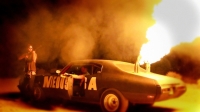- Brian Lafferty
- Review
- movie review
- Ken Cinema
- Landmark Ken
- Landmark Ken Cinema
- Bellflower
- Oscilloscope Laboratories
- Evan Glodell
- Jonathan Keevil
- Kevin MacLeod
- Joel Hodge
- Jessie Wiseman
- Tyler Dawson
- Rebekah Brandes
- Vincent Grashaw
- Pather Panchali
- Eraserhead
- The Evil Dead
- Mad Max
- Cameron Crowe
- Say Anything
- Clerks
- David Lynch
- Satyajit Ray
- Kevin Smith
 By Brian Lafferty
By Brian Lafferty
September 2, 2011 (San Diego) – Satyajit Ray’s Pather Panchali. David Lynch’s Eraserhead. Sam Raimi’s The Evil Dead. Kevin Smith’s Clerks. What does Evan Glodell’s Bellflower have in common with all these films? They are all great movies shot on shoestring budgets.
It seems like the big Hollywood studios are now more than ever gorging on millions of dollars in producing their films. Evan Goldell’s debut film cost only $17,000 to make and it doesn’t look a cent under 17 million.
In Bellflower, Glodell is the wearer of many hats. In addition to producing, directing, writing, and co-editing, he also plays the lead role. He’s Woodrow, a young man who shares with his best friend Aiden (Tyler Dawson) a hobby of building flamethrowers. Oh, and he also likes to upgrade cars with James Bondian capabilities.
He meets and falls in love with Milly (Jessie Wiseman) and the two hit it off. It’s all shattered, however, when Woodrow discovers that she’s cheating on him. He gets angry, and then is hit by a car. The rest of the film deals with his dark, disturbing fantasies as he comes to term with his break-up.
People have described Bellflower as a combination between the films of John Hughes and Mad Max. I didn’t see much of the former. Instead, I saw a lot of Cameron Crowe, particularly Say Anything. Like that movie, the romance between Woodrow and Milly is tender and sweet. The only major difference aside from the lack of a boom box serenade is the ultra-masculine, greased-up atmosphere and the in-your-face demeanor.
In addition to being genuinely romantic, Bellflower is also extremely artistic, much more so than many mega-budget Hollywood extravaganzas. Many scenes brim with bright orange, red, and yellow colors. This is appropriate, considering that Woodrow and Aiden are obsessed with fire. The colors are extremely bold and piercing.
The color scheme and cinematographer Joel Hodge’s camera work combine for the visual in-your-face style. Bellflower uses a mixture of stationary, handheld, and moving shots. I sensed a high degree of confidence on the part of Hodge. Based on his work on this film, I can say he knows how and when to move the camera. The handheld shots don’t venture into the realm of queasy-cam but there’s no timidity either.
This shooting style is mild in the first half. At the start of the second half, Glodell turns up the amplifier on both his demented, depressed performance and the cinematography. Glodell takes no prisoners. Woodrow’s fantasies become increasingly dark and more disturbing. What makes it even more unsettling is that often times it’s impossible to distinguish fantasy from reality. Meanwhile, the camera is livelier, the editing faster (but very comprehensible) and everything else more intense.
Saying that Glodell has talent is stating the obvious. He proves without a doubt that in the film industry it can buy many things but it cannot, however, buy creativity or art. I hope he remembers that when he will no doubt be tempted with large budgets for his future projects.
Bellflower is now playing at the Landmark Ken Cinema.
An Oscilloscope Laboratories release. Director: Evan Glodell. Screenplay: Evan Glodell. Original Music: Jonathan Keevil and Kevin MacLeod. Cinematography: Joel Hodge. Cast: Evan Glodell, Jessie Wiseman, Tyler Dawson, Rebekah Brandes, and Vincent Grashaw. 106 minutes. Rated R.
Brian Lafferty can be reached at brian@eastcountymagazine.org. You can also follow him on Twitter: @BrianLaff.







Recent comments